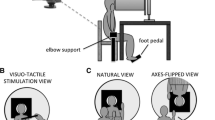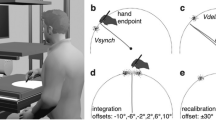Abstract
How do we distinguish “self” from “other”? The correlation between willing an action and seeing it occur is an important cue. We exploited the fact that this correlation needs to occur within a restricted temporal window in order to obtain a quantitative assessment of when a body part is identified as “self”. We measured the threshold and sensitivity (d′) for detecting a delay between movements of the finger (of both the dominant and non-dominant hands) and visual feedback as seen from four visual perspectives (the natural view, and mirror-reversed and/or inverted views). Each trial consisted of one presentation with minimum delay and another with a delay of between 33 and 150 ms. Participants indicated which presentation contained the delayed view. We varied the amount of efference copy available for this task by comparing performances for discrete movements and continuous movements. Discrete movements are associated with a stronger efference copy. Sensitivity to detect asynchrony between visual and proprioceptive information was significantly higher when movements were viewed from a “plausible” self perspective compared with when the view was reversed or inverted. Further, we found differences in performance between dominant and non-dominant hand finger movements across the continuous and single movements. Performance varied with the viewpoint from which the visual feedback was presented and on the efferent component such that optimal performance was obtained when the presentation was in the normal natural orientation and clear efferent information was available. Variations in sensitivity to visual/non-visual temporal incongruence with the viewpoint in which a movement is seen may help determine the arrangement of the underlying visual representation of the body.




Similar content being viewed by others
References
Armel KC, Ramachandran VS (2003) Projecting sensations to external objects: evidence from skin conductance response. Proc R Soc Lond B Biol Sci 270:1499–1506
Astafiev SV, Stanley CM, Shulman GL, Corbetta M (2004) Extrastriate body area in human occipital cortex responds to the performance of motor actions. Nat Neurosci 7:542–548
Benjamini Y, Hochberg Y (1995) Controlling the false discovery rate: a practical and powerful approach to multiple testing. J R Stat Soc Series B Stat Methodol 57:289–300
Botvinick M, Cohen J (1998) Rubber hands “feel” touch that eyes see. Nature 391:756
Brainard DH (1997) The psychophysics toolbox. Spat Vis 10:433–436
Bryden PJ, Pryde KM, Roy EA (2000) A performance measure of the degree of hand preference. Brain Cog 44:402–414
Casasanto D (2009) Embodiment of abstract concepts: good and bad in right- and left-handers. J Exp Psychol Gen 138:351–367
Cole J, Paillard J (1998) Living without touch and peripheral information about body position and movement: studies with deafferented subjects. In: Bermudez J (ed) The body and the self. MIT Press, Cambridge, pp 245–266
Conson M, Aromino AR, Trojano L (2010) Whose hand is this? Handedness and visual perspective modulate self/other discrimination. Exp Brain Res 206:449–453
Costantini M, Haggard P (2007) The rubber hand illusion: sensitivity and reference frame for body ownership. Conscious Cogn 16:229–240
Downing PE, Jiang Y, Shuman M, Kanwisher N (2001) A cortical area selective for visual processing of the human body. Science 293:2470–2473
Dyde R, MacKenzie K, Harris L (2011) How well do you know the back of your hand? Reaction time to identify a rotated hand silhouette depends on whether it is interpreted as a palm or back view. J Vis 11:868
Farrer C, Franck N, Georgieff N, Frith CD, Decety J, Jeannerod M (2003) Modulating the experience of agency: a positron emission tomography study. NeuroImage 18:324–333
Fiorio M et al (2007) Defective temporal processing of sensory stimuli in DYT1 mutation carriers: a new endophenotype of dystonia? Brain 130:134–142
Gallagher I (2000) Philosophical conceptions of the self: implications for cognitive science. Trends Cogn Sci 4:14–21
Graziano MS (1999) Where is my arm? The relative role of vision and proprioception in the neuronal representation of limb position. Proc Natl Acad Sci USA 96:10418–10421
Holmes NP, Spence C (2007) Dissociating body image and body schema with rubber hands. Exp Brain Res 166:489–497
Làdavas E, Farnè A, Zeloni G, di Pellegrino G (2000) Seeing or not seeing where your hands are. Exp Brain Res 131:458–467
Lau HC, Rogers RD, Haggard P, Passingham RE (2004) Attention to intention. Science 303:1208–1210
Macmillan NA, Creelman DC (1991) Detection theory: a user’s guide. Cambridge University Press, New York
Maruff P, Wood SJ, Velakoulis D, Smith DJ, Soulsby B, Suckling J, Bullmore ET, Pantelis C (2005) Reduced volume of parietal and frontal association areas in patients with schizophrenia characterized by passivity delusions. Psychol Med 35:783–789
Mather JA, Lackner JR (1981) The influence of efferent, proprioceptive, and timing factors on the accuracy of eye-hand tracking. Exp Brain Res 43:406–412
Oldfield RC (1971) The assessment and analysis of handedness: the Edinburgh inventory. Neuropsychologia 9:97–113
Parsons LM (1994) Temporal and kinematic properties of motor behavior reflected in mentally simulated action. J Exp Psychol Hum Percept 20:709–730
Peelen MV, Downing PE (2007) The neural basis of visual body perception. Nature Rev Neurosci 8:636–648
Pelli DG (1997) The VideoToolbox software for visual psychophysics: transforming numbers into movies. Spatl Vis 10:437–442
Spence C, Pavani F, Maravita A, Holmes N (2004) Multisensory contributions to the 3-D representation of visuotactile peripersonal space in humans: evidence from the crossmodal congruency task. J Phys 98:171–189
Spencer RMC (2003) Disrupted timing of discontinuous but not continuous movements by cerebellar lesions. Science 300:1437–1439
Spencer R, Verstynen T, Brett M (2007) Cerebellar activation during discrete and not continuous timed movements: an fMRI study. NeuroImage 36:378–387
Swinnen SP (2002) Intermanual coordination: from behavioural principles to neural-network interactions. Nat Rev Neurosci 3:348–359
Tsakiris M, Haggard P, Franck N, Mainy N, Sirigu A (2005) A specific role for efferent information in self-recognition. Cognition 96:215–231
Tsakiris M, Prabhu G, Haggard P (2006) Having a body versus moving your body: how agency structures body-ownership. Conscious Cogn 15:23–432
Tsakiris M, Carpenter L, James D, Fotopoulou A (2010) Hands only illusion: multisensory integration elicits sense of ownership for body parts but not for non-corporeal objects. Exp Brain Res 204:343–352
Willems RM, Hagoort P (2009) Hand preference influences neural correlates of action observation. Brain Res 1269:90–104
Willems RM, Ozyürek A, Hagoort P (2009a) Differential roles for left inferior frontal and superior temporal cortex in multimodal integration of action and language. NeuroImage 47:1992–2004
Willems RM, Toni I, Hagoort P, Casasanto D (2009b) Body-specific motor imagery of hand actions: neural evidence from right- and left-handers. Front Hum Neurosci 3:39
Willems RM, Hagoort P, Casasanto D (2010) Body-specific representations of action verbs: neural evidence from right- and left-handers. Psychol Sci 21:67–74
Winter R, Harrar V, Gozdic M, Harris LR (2008) The relative timing of active and passive touch. Brain Res 1242:54–58
Wolpert DM (1997) Computational approaches to motor control. Trends Cogn Sci 1:209–216
Acknowledgments
This work was supported by the Natural Sciences and Engineering Research Council of Canada (NSERC) grant to LRH. AENH held a PGS-D2 NSERC graduate scholarship.
Author information
Authors and Affiliations
Corresponding author
Rights and permissions
About this article
Cite this article
Hoover, A.E.N., Harris, L.R. Detecting delay in visual feedback of an action as a monitor of self recognition. Exp Brain Res 222, 389–397 (2012). https://doi.org/10.1007/s00221-012-3224-3
Received:
Accepted:
Published:
Issue Date:
DOI: https://doi.org/10.1007/s00221-012-3224-3




